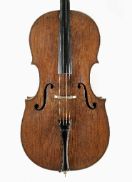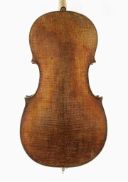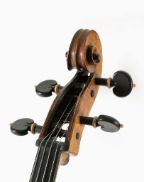Violoncello, Alessandro Gagliano, Naples, about 1710
Printed label: “Alexandri Gagliano Alumnus / Stradivarius fecit Neapoli anno 1708”According to the printed label in the instrument, this cello was crafted by Alessandro Gagliano. The most recent research has shown that he did not apprentice to any of the Cremonese masters. His instruments have very characteristic, independent features: The contours, f-hole design and the scrolls are quite individualistic. The belly is made of conifer wood with regular growth and medium-wide annual rings. A wing was added on the treble side, a common fix allowing makers to use resonance wood that was not wide enough to cover the lower bouts completely. As adding wings does not affect sound, this approach was frequently used for cellos and, more rarely, for violins. A dendrochronological analysis showed the youngest tree ring to be from 1698, corroborating the current assumption of the year in which the instrument was made. The two-piece back cut on the quarter is made of vividly flamed, bookmatched maple. The ribs also display intense flaming.
Gagliano’s individualistic touch is most evident in the design of the body contours. Just after 1700, Stradivari had developed a model he called “Forma B,” which is still considered the gold standard today for its well-balanced proportions and the compromise between good playability and sonority. Gagliano’s model, however, has much shorter C-bouts and longer lower bouts. Moreover, the f-holes are somewhat lower, increasing the f-stop length to above average. The f-holes are nicely curved, and the upper and lower eyes were cut nearly the same size. Gagliano also added a distinctive touch to his design of the pegbox and the scroll: The scroll is very narrow, and the pegbox has two openings on the back. While these make it easier to thread the strings into the string holes of the pegs, they also impair the stability of the pegbox, which has to withstand the tension of the four strings. Alessandro Gagliano used a soft, fairly dark, oil-based varnish that contributes substantially to the attractiveness of his instruments.





